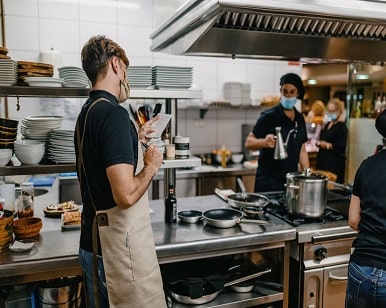Establishing Eateries Now Affordable
The cloud kitchen market size was valued at US$38.926 billion in 2020 and is anticipated to increase at a Compound Annual Growth Rate of 12.52% over the predictive period to reach US$88.889 billion by 2027.
Cloud kitchens (also known as ghost kitchens) are a modern food preparation facility that only provides food for delivery. Some cloud kitchens also provide takeaway and drive-thru options. Most cloud kitchens do not have a storefront or a physical restaurant space. They only contain a kitchen or cooking facility, sometimes for more than one restaurant.
Types of Ghost Kitchens
Standalone Cloud Kitchen: – This is the most basic and widely used form of cloud kitchen. These kitchens are generally operated under a single restaurant brand and have a limited preparation space. Some of these eateries may have formerly operated as full-fledged restaurants, but have since reduced expenses and expanded their reach by focusing only on delivery and takeout.
Multi-brand Cloud Kitchen: – A multi-brand cloud kitchen contains one large kitchen space, where several restaurant brands work, owned by one parent company. A multi-brand cloud kitchen allows companies to reduce production costs by providing a shared floor space and also helps in achieving efficient managing techniques.
Outsourced Cloud Kitchen: – These kinds of kitchens partially prepare large amounts of food, which is then sent to a satellite kitchen, where the food is cooked one final time, before delivering it to the public. Outsourced cloud kitchens provide an opportunity for cloud kitchens to facilitate faster delivery and efficient cooking methods.
Co-Working Cloud Kitchen: –These kinds of cloud kitchens contain individual kitchen units for multiple restaurant brands under one kitchen space. The kitchen units are usually rented out to multiple restaurant brands, allowing kitchens to operate efficiently without having to purchase the whole space area.
Requirements for a Cloud Kitchen
Location and License: – Since cloud kitchens do not facilitate physical restaurants, they do not require a high-end location. However, strategic selection of the location is necessary for prompt delivery and service. For instance, setting up a cloud kitchen near a place that is visited by a lot of young individuals, like universities, would be beneficial for cloud kitchens to ensure faster delivery and better service. Since most cloud kitchens do not require a lot of facilities, they can be set up in places like empty parking lots, residential areas, or even in food trucks.
Most cloud kitchens do not require any complex licensing or paperwork. However, since consumers are not able to visit the establishment themselves, the production of certifications or awards would help in inspiring confidence among the people.
Kitchen Equipment and Staff: – The equipment required to set up a cloud kitchen would be similar to that of setting up a restaurant, except for dining sets and cutlery. They would require cooking utensils and facilities for storing and heating. Additionally, cloud kitchens would also require disposable packaging equipment such as plates, cutlery, and cups.
A cloud kitchen could start operating with very limited employees. The only personnel initially required to start a cloud kitchen would be cooks, delivery personnel, and cleaning staff. Any other personnel required could be adjusted as the business starts making profits. Additionally, a cloud kitchen could also employ someone to receive orders and look after the ordering system.
POS or Online Ordering System: – A cloud kitchen would require a POS system or any other similar system, to register and allot food orders, and review receipts accordingly. A cloud kitchen would also require someone to receive orders and look after the online ordering system.
Food Delivery System: – The main aspect of a cloud kitchen is to provide food delivery services that are fast. For this, a cloud kitchen would require dedicated food delivery personnel to take food orders and deliver them on time. Some online food delivery applications, like Uber Eats, however, provide delivery options for the kitchens, through which they employ other third-party personnel to deliver the food for them. However, such services charge a small fee from the restaurants for this.
For facilities that allow customers the facility to drive-thru or takeaway, they would also require dedicated staff to hand out food to the people.
Covid-19 Insight
The hospitality sector was worse hit by the COVID-19 pandemic. However, the pandemic had a positive effect on the cloud kitchen market and emerged as a popular trend. With an increase in the spread of the virus, the pandemic created a demand for minimal contact food delivery, leaving traditional dine-in restaurants behind. According to Barclaycard UK, the takeaway sector recorded an increase in expenditure of 11.4%, due to the pandemic. This led to an expansion of the cloud kitchen market and is expected to see further growth in the future.
Cloud Kitchen Market Scope:
| Report Metric | Details |
| Market Size Value in 2020 | US$38.926 billion |
| Market Size Value in 2027 | US$88.889 billion |
| Growth Rate | CAGR of 12.52% from 2020 to 2027 |
| Base Year | 2020 |
| Forecast Period | 2022–2027 |
| Forecast Unit (Value) | USD Billion |
| Segments Covered | Business Model, Order Source, And Geography |
| Regions Covered | North America, South America, Europe, Middle East and Africa, Asia Pacific |
| Companies covered | KLC Virtual Restaurants, The Food Corridor (Fort Collins, CO), Kitopi, CloudKitchen, Muy, Mimic, Franklin Junction, Zullu, Virturant, Keatz, Travis Kalanick, Karma Kitchen, Deliveroo |
| Customization scope | Free report customization with purchase |



